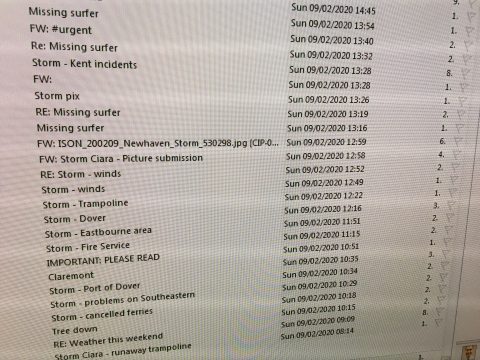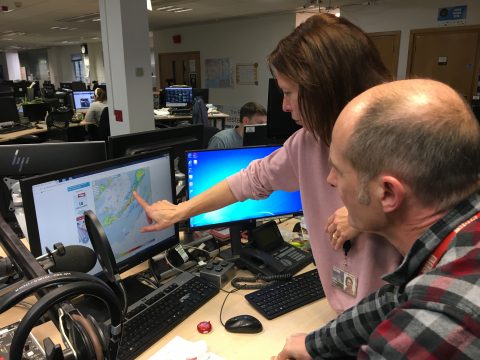People who work in newsrooms don’t really think of themselves as being particularly ‘agile’. It’s what we do. But dealing with breaking news does demand agility, and in my case, has demanded it for just over thirty years.
If you’ve read this far it’s probably because you know that I’ve spent much of the past six years of my career analysing what we actually do in newsrooms, and distilling that into ideas (and very lively workshops) that can help businesses become more agile. And last Sunday gave me plenty to analyse. I was on the 2pm to 10pm presenting shift, and Storm Ciara was about to hit.
So here are five thoughts that may be useful next time a storm is about to hit in your workplace.

Welcome to the newsroom
1. Go into scanning mode. Here’s a photo of just some of the email updates that had come in from various colleagues and news sources when I came on shift. Each email probably contained enough information to fill half the bulletin. In newsrooms, you soon learn it’s okay to scan a mountain of information, but only actually use the information that you judge most stands out.
2. Be prepared to drop things. By 2pm we had several pictures of trees on roads, people taking chances on beaches, a surfer washed up alive in Rye, a warning from the RNLI urging people to be careful on the coast, and a trampoline cartwheeling onto a residential street. That alone could have filled the 2 minute news report we had planned. By 4pm, the M20 was closed because a lamp-post was down. We judged that image, and its consequences, were strong — so two of the shots of fallen trees had to go. By 5.15pm, we’d heard that six platforms at Victoria Station were closed because of damage to the roof. A sentence about that went in, a second sentence about people taking chances on the beaches came out.

No nonsense Nina shows me what’s going on.
3. Be a rebel. In our weekend bulletins, the weather forecast is allocated 1 minute. But on an evening like this, I judged the forecast was arguably the one thing our audiences most needed to see. I broke convention and asked Nina, our weather forecaster, for 1 minute 45 seconds instead. She smiled broadly.
4. Don’t try to do it all. Poppy, the producer working with me on this bulletin, is in her late twenties and red hot on social media. I’m in my early fifties, and luke warm. We agreed she would work on handling the pictures coming in on Twitter and Facebook, while I picked up the good old phone to check details with the emergency services.

Strongest shot of the day, courtesy of RNLI
5. And finally — don’t insist on perfection. At 5.40pm, I needed to go into the studio to rehearse ahead of our bulletin at 6pm. Poppy needed to be in the news gallery with the director. Sure enough, at 5.45pm we spotted pictures posted online by the RNLI of one of their rescue boats all but capsizing as it attempted to rescue that surfer. They were by far the strongest images on a vivid day. But with 15 minutes to air, and all focus on rehearsing what we had, a tough decision had to be made. To try to download them, edit them, write a script about them, fit them into the bulletin and find something else to drop to make room for them … well, it was too risky. It could have jeapordised our entire bulletin. So we left them out, and broadcast what we had already prepared. It wasn’t a perfect news bulletin on the day’s dramas. But it was — though I say it myself — a pretty good one. Any news editor will tell you that the perfect news bulletin has yet to be broadcast.
I headed home through the dregs of the storm thinking: job done. I was pleased that both our 6pm and our 10pm bulletin (which did include those shots of the lifeboat) were the best we could do in the circumstances.
Do you always insist on the best from your teams and yourself — or the best in changing circumstances? Are you prepared to drop things, and tolerate a little on the spot rebellion, when priorities change?
Do you dread the stormy days — or see them as an opportunity to put your agility to the test? You may find that challenge as refreshing as a blustery walk on the beach.
If you’d like to test your team’s agility, while having some fun, my No Bull Newsroom might be just the ticket. You and your staff experience a real-time simulated newsroom experience — and nobody gets wet by stepping outside of the office.